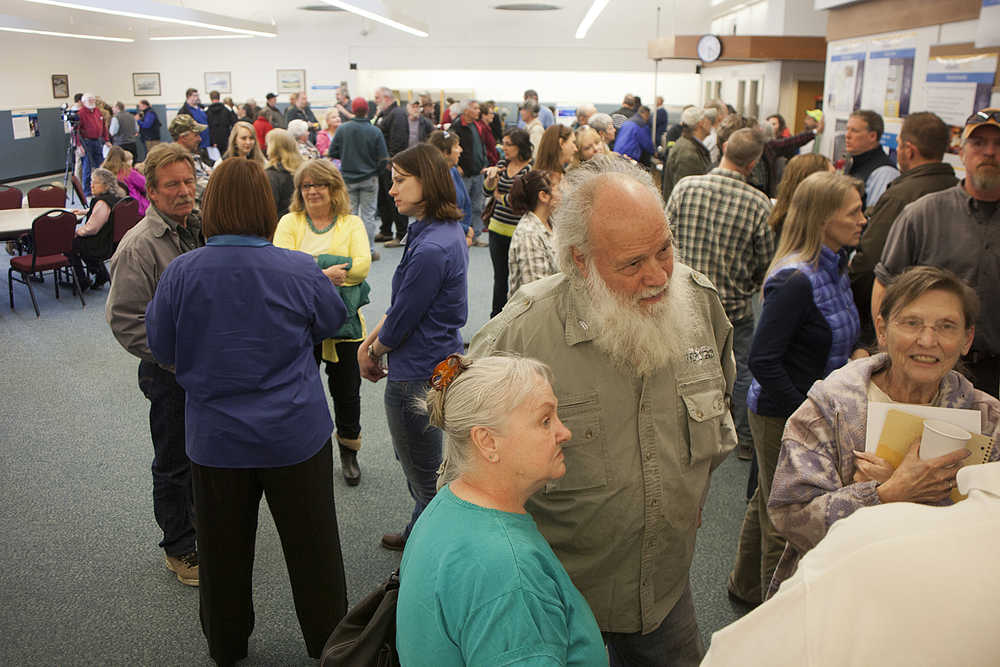How much noise is it going to make? How will Nikiski handle the influx of people and resulting crime if the Alaska LNG project goes forward? Will the project hire local companies to do some of the construction work on the mega-project? When will the community know if the project will go forward and Nikiski will get a pipeline?
More than 150 people crowded into the Nikiski Community Recreation Center for the second open house meeting hosted by the Alaska LNG project organizers. As details emerge of the $45 billion to $65 billion dollar plan to pipe gas from the North Slope and Prudhoe Bay to the Kenai Peninsula, curious community members inundated Alaska LNG staff with questions — many of which have been lingering for months, as the project acquires land and moves through the extensive regulatory process required for it to be approved.
“There are some common themes tonight and understandably so,” said Alaska LNG Project Advisor Jeff Raun, such as, “‘how does this project affect me as a landowner or a recreational user in these areas?’ I expect those questions to continue to be asked as the project continues to refine where the facilities are going to be locaed and what the landscape is going to look like, based on those facilities.”
For some, the questions are ones that will be more easily answered once plans for the facilities are solidified.
Janet Miller said she had been tasked by her husband with finding out how much noise the LNG facility and pipeline would bring to the community. The Millers live on Douglas Lake — about 3 miles away from any planned facility.
“I haven’t heard a lot about the noise,” she said.
For others, other concerns weigh heavily.
“I’ve been reading about the Dakotas and they are overrun with crime,” said Chuck Johnson, of Nikiski. “The population tripled and those small towns were overrun. How are they going to help figure out the crime?”
Johnson said he remembered a similar influx of people when the oil platforms were built in the Cook Inlet. But, he said, he can’t get a straight answer to his question.
“They say it’s under study,” he said with a laugh.
What is clear, is that the project is progressing and organizers are going into the 2015 season with a number of studies in the works.
A highway relocation feasibility study has been launched and many asked about the future of the Kenai Spur Highway during the meeting. A consulting firm has been hired and project organizers are working with the Alaska Department of Transportation to develop concepts for the two-lane highway.
“We’ll be reaching out at the end of the year for public involvement and some type of engagement,” Raun said.
One thing that has changed in the months since the last community meeting is the corridor the pipeline will likely take as it crosses the Cook Inlet.
The project has gone from two potential corridors in the Cook Inlet to a preferred route that pushes it to the west.
“There are a number of considerations, of course current in the Cook Inlet, potential engineering hazards associated with the substrate and also the exit and entry points,” Raun said.
During 2015, further studies will be done on that route including geotechnical drilling in the Cook Inlet. Raun said people would likely see those studies being performed midsummer.
Staff also encouraged community members to sign up for one of the four upcoming business information sessions being held in Barrow, Fairbanks, Anchorage and Kenai. Raun said more than 150 people had signed up to attend the April 29 session at the Cannery Lodge in Kenai.
Project organizers are looking for businesses that can provide bulk materials like gravel, sand and concrete, camp operation support services like catering and water supply companies, pre-engineered and modular buildings, construction equipment, environmental consultation and a number of freight delivery and emergency service suppliers.
While the finished project is more than 10 years out, organizers said they were happy to see the volume of community interest.
“We’re at an exciting time both on the project and off and we’re looking forward to working again with the community during our field programs,” Raun said.
Reach Rashah McChesney at rashah.mcchesney@peninsulaclarion.com or follow her on Twitter @litmuslens.

